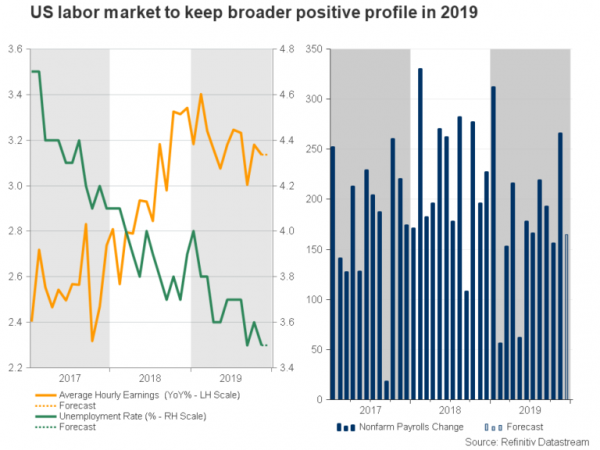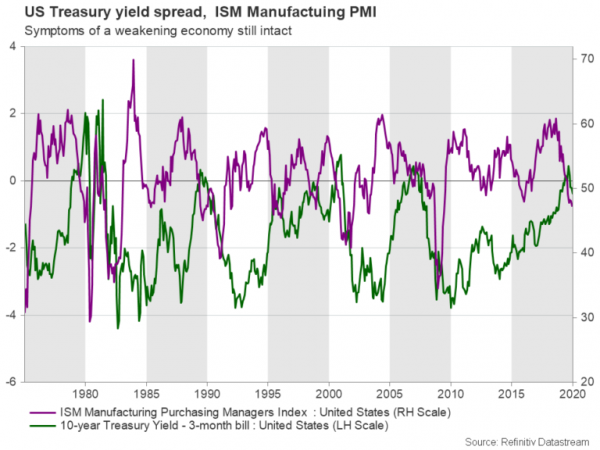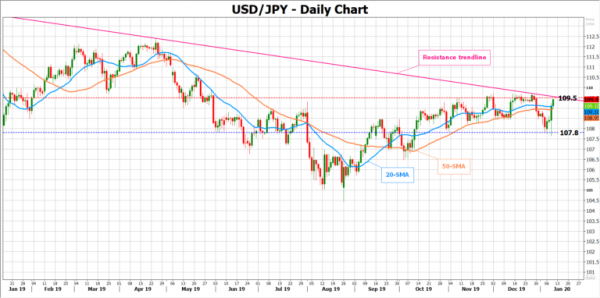The US is scheduled to publish its final Nonfarm payrolls report (NFP) for 2019 on Friday at 12:30 GMT and despite the ups and downs during the year and a potential slowdown in employment growth this week, the labor market is expected to have maintained a robust profile, reducing the odds for a more accommodative monetary policy. The dollar, though, may consider the data outdated, probably showing little volatility in the aftermath.
NFP forecasts
Sharp dips in employment growth during 2019 mirrored the elevated business uncertainty about the future of the US economy in the face of the bitter US-China trade war and a slowing global growth. In November, however, nonfarm payrolls unexpectedly spiked above 200k to a 10-month high as General Motors’ striking employees returned to work and the healthcare sector boosted hiring, relieving markets that the jobs market is still holding its ground. A fall back in the unemployment rate and upward revisions to the October and September readings added more sparkle to the NFP report.
This week, the December delivery may not be as glamorous as the preceding one but could still be representative of a tightening labor market and of a resilient economy. Particularly, expectations are for an employment growth of 165k which is above the 100k threshold required to keep up with a growing working-age population and a steady unemployment rate at a 50-year low of 3.5%. In terms of wages, average hourly earnings are forecast to increase by 0.3% month-on-month compared to 0.2% in November, keeping the yearly rate flat near decade highs at 3.1% for the second consecutive month.
The December ISM Manufacturing PMI survey released last week has already warned investors that a muted set of employment numbers on Friday is possible. The index, which is a widely watched indicator of recent manufacturing activity, tumbled to fresh lows in the contraction area, falling from 48.1 in November to a decade low of 47.2, with sub-indices such as the employment index following suit. Note that the measure should fall below 43 to flag a wider economic recession.
How the Fed will react?
Nonetheless, the Fed believes that conditions in the US labor market could get even better citing the progress in the US-China trade war and more clarity on the Brexit front. But it has clearly messaged that interest rates will not change in either direction in the foreseeable future even if inflation rises above its 2.0% target. Therefore, Friday’s NFP readings may not affect the Fed’s stance. Instead policymakers will wisely wait and see whether the cocktail of the current lower interest rates and a less risky trade environment – once the US-China and the new NAFTA trade deals get signed – will boost business and consumer confidence in the first quarter of 2020 , with inflation and manufacturing and services PMI data eagerly watched for any signs of strength. For now, the aforementioned indicators continue to show symptoms of a deteriorating economy. The inversion of the 10-year and 3-month US Treasury yields in August is another reason why the outlook for the US economy remains somewhat suspicious.
Where now for the dollar?
As the focus turns to 2020 data, the dollar may show muted reaction to the December NFP report that may be considered outdated. Recall that the downbeat ISM manufacturing and services PMI figures released last Friday and Tuesday respectively moved little the greenback.
Nevertheless, surprises happen and investors could keep in mind the 107.80 level in the USDJPY market if the jobs data disappoint significantly. On the other hand, stronger-than-expected readings would keep attention on the 109.50 area and the resistance trendline that has been holding since September 2018.
In Wall Street, a beat in the data and specifically on the wage front could be negative for US stocks and for the S&P 500 as this would translate to higher costs for US corporations and vice versa.
















